Through the courtesy of YouTube, here's a special treat for Elvis fans:
Monday, September 25, 2006
Blog As Personal Journal
Earliest Journal(cover page):
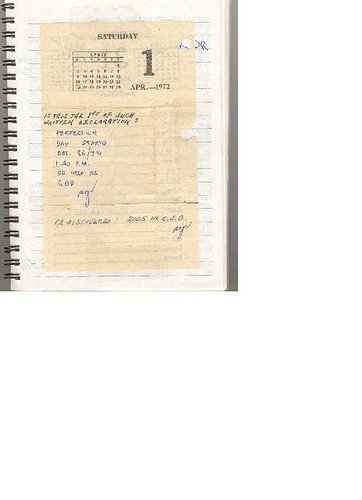 We know that weblogs, or more popularly, blogs, are a product of the present century. Spread out and popularized through the medium of the Internet.
We know that weblogs, or more popularly, blogs, are a product of the present century. Spread out and popularized through the medium of the Internet.
But just as surely, we know that personal journals have been with us for a long, long time. So long, perhaps, that remaining documents attesting to this have become ageless, timeless, and never the mind.
The biggest change over time, of course, has been that while personal journals were simply that, personal, the present ones, the blogs, are as public as public can get. Everybody with an Internet connection has access to them, whether the creators are so inclined or not.
So, bloggers, out there if you still want to maintain a modicum of privacy in your very personal and intimate scribbling then at the very least, place your blogsite behind some kind of intranet wall so that only those you have chosen can access them. And/or add some log-in protection via user name and password.
If you have a URL, then as its name suggests your blog can be uniformly located by anybody with an Internet connection. And even if you do not advertise your blog, those diligent search engines will do their best to point a finger toward your direction.
So now, blogs are great and fashionable, and commonplace; and millions have joined in to try their own.
But what about those who shun the Internet, but have always kept their own personal journals? Or those who do want to keep personal journals but do not want to plaster them where the entire world can read them?
I am sure you are still out there, thriving in private and with no vain desire to share your innermost thoughts with the world, nor any fearless desire to make known what and how you are doing.
Well, then, kindred souls, feel not being alone and left out. Count me as one among you, still a fervent disciple of personal journals that are still personal and private.
Some time ago when I recollected on this practice and made an inventory, I discovered some very interesting and nostalgic insights. Insights that I would like to share, though still behind a hazy veil of anonymity and blurry words.
Current Journal:
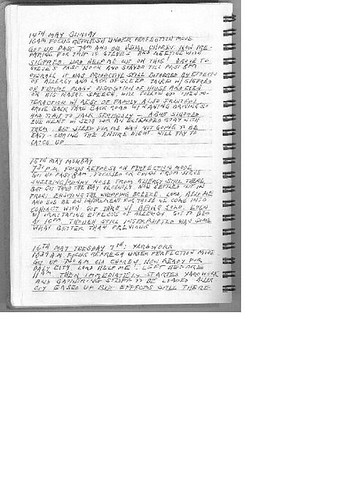
Scrounging through old files from the old homeland, I was able to salvage among other miscellany the cover page of a very early journal book in the early 70’s, the earliest I can find.
Samples of Earlier Journals:
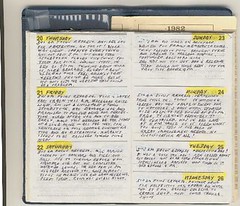
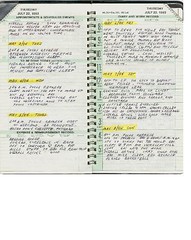
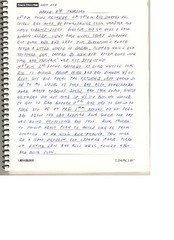
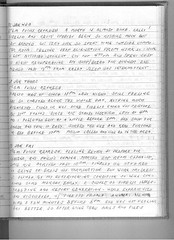
That and succeeding journals show certain common threads. They were all written using words block-printed, rather than in the typical cursive fashion. They were written on a daily basis, using some determinable format. But on papers or books that varied in size, thickness, and ruling. Using either fountain pen, or ballpoint pens, but never pencil. And typically, I noticed on media that were not purposely intended to be used as personal journal, but rather as schedulers, school notebooks, and even hardbound ledgers. Lately, though I have been looking around for journal books intended primarily for the purpose.
The subject matters? As diverse as the faces in a UN general assembly meeting. But definitely topics/concerns, which at the time of writing were floating and craving for attention in my mind. Just like what a personal journal should contain.
So to this day, daily I continue to trudge along, lending and committing words to paper, in the same self-same tedious manner of manually printing out words.
To all of us out there, carry on and more power!
 We know that weblogs, or more popularly, blogs, are a product of the present century. Spread out and popularized through the medium of the Internet.
We know that weblogs, or more popularly, blogs, are a product of the present century. Spread out and popularized through the medium of the Internet.But just as surely, we know that personal journals have been with us for a long, long time. So long, perhaps, that remaining documents attesting to this have become ageless, timeless, and never the mind.
The biggest change over time, of course, has been that while personal journals were simply that, personal, the present ones, the blogs, are as public as public can get. Everybody with an Internet connection has access to them, whether the creators are so inclined or not.
So, bloggers, out there if you still want to maintain a modicum of privacy in your very personal and intimate scribbling then at the very least, place your blogsite behind some kind of intranet wall so that only those you have chosen can access them. And/or add some log-in protection via user name and password.
If you have a URL, then as its name suggests your blog can be uniformly located by anybody with an Internet connection. And even if you do not advertise your blog, those diligent search engines will do their best to point a finger toward your direction.
So now, blogs are great and fashionable, and commonplace; and millions have joined in to try their own.
But what about those who shun the Internet, but have always kept their own personal journals? Or those who do want to keep personal journals but do not want to plaster them where the entire world can read them?
I am sure you are still out there, thriving in private and with no vain desire to share your innermost thoughts with the world, nor any fearless desire to make known what and how you are doing.
Well, then, kindred souls, feel not being alone and left out. Count me as one among you, still a fervent disciple of personal journals that are still personal and private.
Some time ago when I recollected on this practice and made an inventory, I discovered some very interesting and nostalgic insights. Insights that I would like to share, though still behind a hazy veil of anonymity and blurry words.
Current Journal:

Scrounging through old files from the old homeland, I was able to salvage among other miscellany the cover page of a very early journal book in the early 70’s, the earliest I can find.
Samples of Earlier Journals:




That and succeeding journals show certain common threads. They were all written using words block-printed, rather than in the typical cursive fashion. They were written on a daily basis, using some determinable format. But on papers or books that varied in size, thickness, and ruling. Using either fountain pen, or ballpoint pens, but never pencil. And typically, I noticed on media that were not purposely intended to be used as personal journal, but rather as schedulers, school notebooks, and even hardbound ledgers. Lately, though I have been looking around for journal books intended primarily for the purpose.
The subject matters? As diverse as the faces in a UN general assembly meeting. But definitely topics/concerns, which at the time of writing were floating and craving for attention in my mind. Just like what a personal journal should contain.
So to this day, daily I continue to trudge along, lending and committing words to paper, in the same self-same tedious manner of manually printing out words.
To all of us out there, carry on and more power!
Saturday, September 23, 2006
An Unusual Philately Find
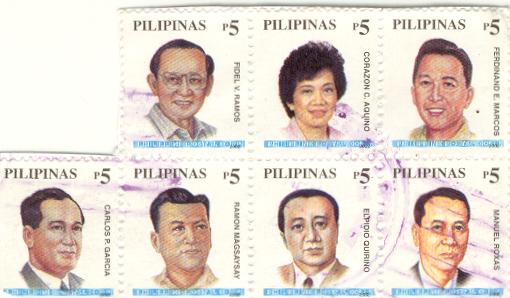
Seven presidents of the Republic of the Philippines on one sheet of postage stamps.
Presidents commencing from the 2nd Republic up to the 5th, but minus the incumbent’s father, Diosdado Macapagal, and deposed Joseph Estrada. And of course, minus the incumbent, Gloria Macapagal Arroyo.
Would be interesting to find out who else the entire sheet featured.
The Filipino Heritage site had this to say:
Since then, the country has issued thousands of stamps (2,500 different ones from 1946 to 1996), including regular issues promoting heroes, presidents, and other prominent Filipinos; commemoratives marking significant historical milestones, and colorful special issues displaying the country's flora (especially orchids and medicinal plants) and fauna. Major landmarks and scenic spots are on stamps too, as are native costumes, folk dances, and festivals. Some 20 issues honor schools and universities. Reproductions of paintings have appeared. A scenic and cultural tour of the Philippines can be made through its stamps.
But no mention of the featured stamps.
Here’s an interesting comment:
I have been reading with interest your items concerning postage stamps that seemed to represent waivers to the rule that people have to be dead for ten years before their likenesses are allowed on stamps (Presidents excepted). However, I must clear up a misconception here: the "ten years" rule was not adopted by the CSAC (Citizens' Stamp Advisory Committee) until some time in the late 1960s. Until then, there were no limitations concerning a person's appearance on a postage stamp (so long as that person was deceased). During the 1950s and early 1960s, the U.S. issued many memorial stamps to those who had recently died; besides Disney and Hammarskjold, these included Philippine President Ramon Magsaysay (1957), Ernst Reuter, mayor of (West) Berlin (1959), former Senators Robert Taft and Walter George (1960), Secretary of State John Foster Dulles (1960), Speaker of the House Sam Rayburn (1962), Eleanor Roosevelt (1963), and in 1965, Winston Churchill and Adlai Stevenson.
Interesting info. Not only that Magsaysay was featured on a US stamp, but learning about the ten-year rule on deaths.
Subscribe to:
Comments (Atom)